I am now heading for the final push on the big winter cutback, ideally everything should be cut back in your garden before the end of January. If you leaving cutting back much later then you are likely to be cutting off this years growth. This last bit is always heavy going for me as I leave the big heavy stuff to the last so that I can build up my courage and stamina. The very last thing I do is reshape my big Ficus tree which is a bloody painful experience each year.
As if dealing with the most stressful part of the big cutback was not enough, I spend most of my evenings preparing my defence against the summons served on me by the Chief Diversity and Inclusion Officer of the National Chicken Council on account of my alleged slander of calling Cruella (my wife) chickens fat. Anyway more of this later, on with the big cutback part 3.
27th January 2023. Things I have been doing lately:
Cutting back my tower of flowers. Regular readers of this blog will know that years ago I cut back a palm that had fallen victim to the Palm Weevil. Instead of completely taking the Palm out I instead wrapped it’s shortened trunk in mesh and have happily grown a variety of climbers up the truncated trunk. This provides me with a lovely tower of flowers all summer, but needs to be cut back every winter to encourage new growth.
In case you are interested the plants I used to clamber up the trunk include:
- Pink Trumpet Vine
- Solanum
- Jasmine
- Stephanotis
All of the above flourish beautifully. The first photo below shows the flowering tower at the end of Summer. The next two photos show the tower before and after it’s annual cutback. Click on each photo for a larger view.



Pruning a variegated ficus. I have two variegated ficus one is quite small, whilst the other is larger and I have subjected it to cloud pruning. The secret with any variegated plant is to make sure that the moment you see a fully green leaf you instantly pluck it out. You can quite easily lose variegation as the green leaves can prove very dominant and will soon take over. Spain’s gardens are full of variegated ficus that have lost their variegation and are now common or garden old ficus – you have been warned, don’t come crying to me.
Ficus are relatively slow growing and are very forgiving if you prune them a little badly. My poor old ficus can be seen in the photos below before and after being subjected to my artistic pruning. My aim is to produce an inchoate, but interesting shape whilst exposing the stark white of the bark – good eh! Click on each photo for a larger view.
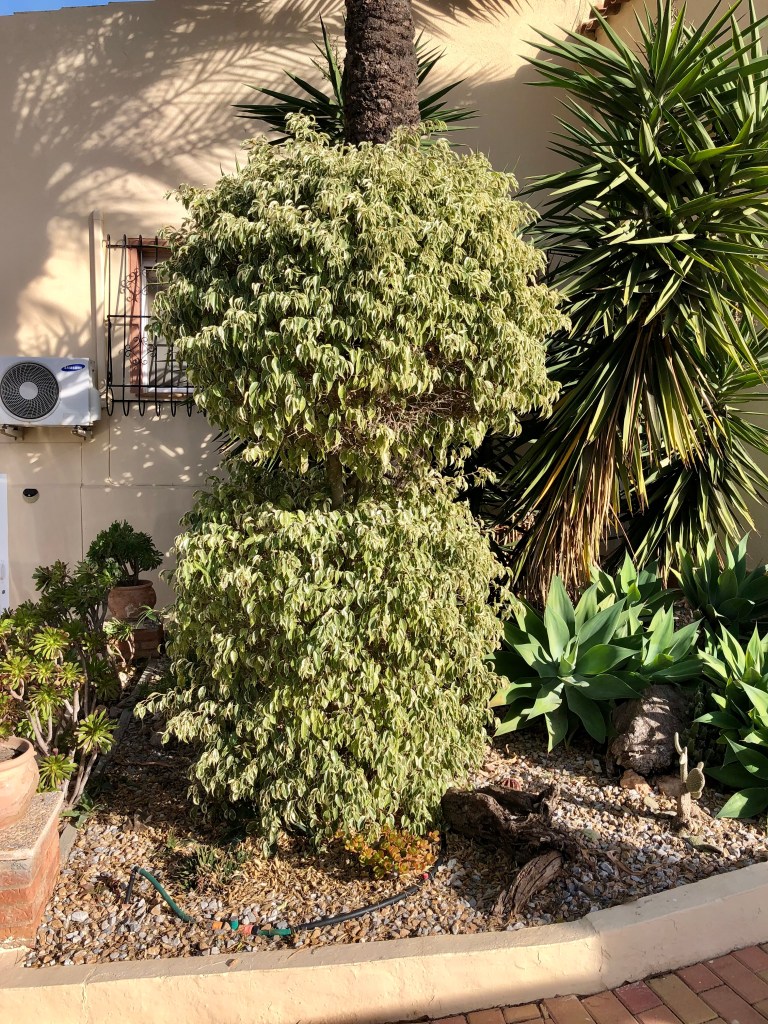

Maintaining the sight lines for my European Fan Palms. If you read my last post, and I am sure that you did, then you will remember that I wrote about the importance of sight lines in your garden. Sight lines are views or vistas in your garden that perform the function of providing a special view or focal point integral to a particular part of your garden. My European fan palms perform a dual function they give a privacy from my front gate and present a dramatic entrance for guests, whilst at the same time presenting a stunning sight line from the house.
These palms are lovely, but they grow like crazy and happily self seed around themselves. This means that get very top heavy with abundant new fronds whilst at the same time becoming overcrowded at the base. The first photo below shows the unpruned plant viewed from the gate towards the house and secondly from the house to the gate. From these photos you can see the problem. Click on each photo for a larger view.


After much vigorous pruning shown in the two photos below, the sight line can be seen fully restored in the final photo. It is important to note that when pruning any large palm you must wear eye protection or you can easily be damaged by their spiked stems. It is bad enough that they shred your clothes without losing an eye. Click on each photo for a larger view.
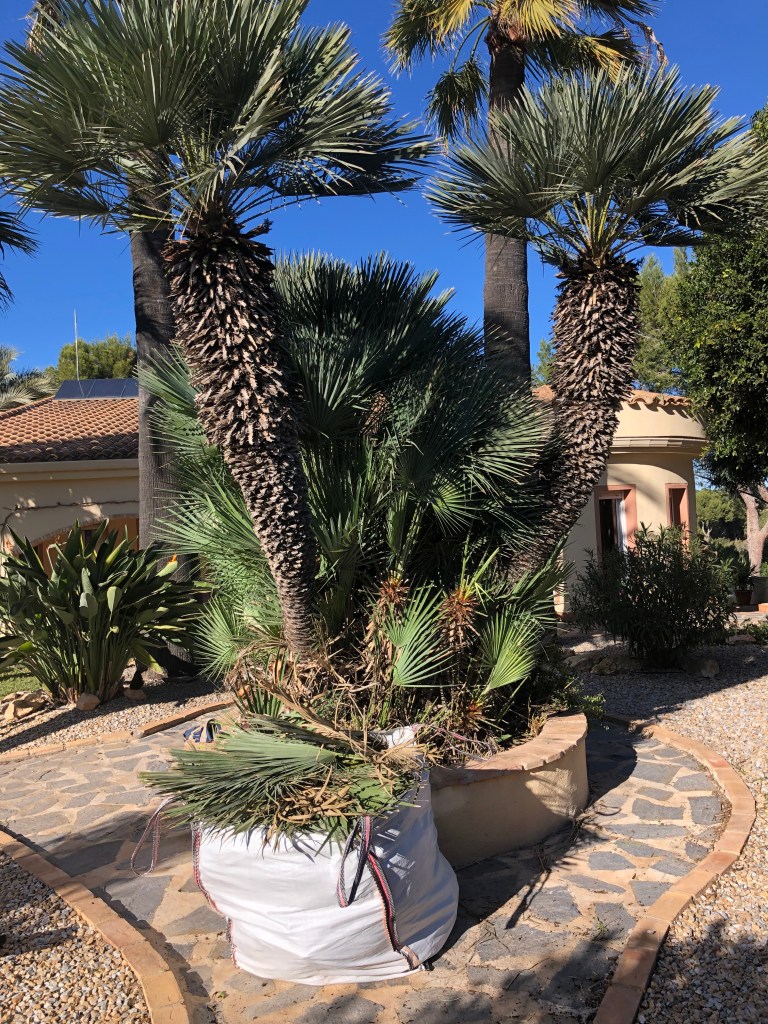
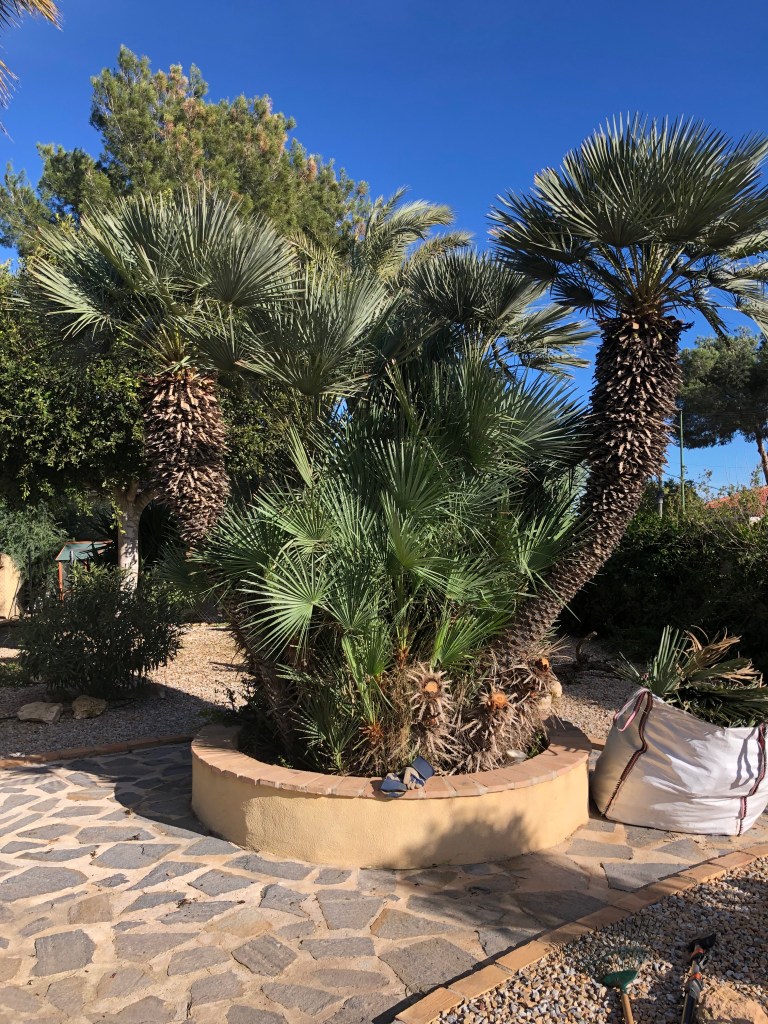
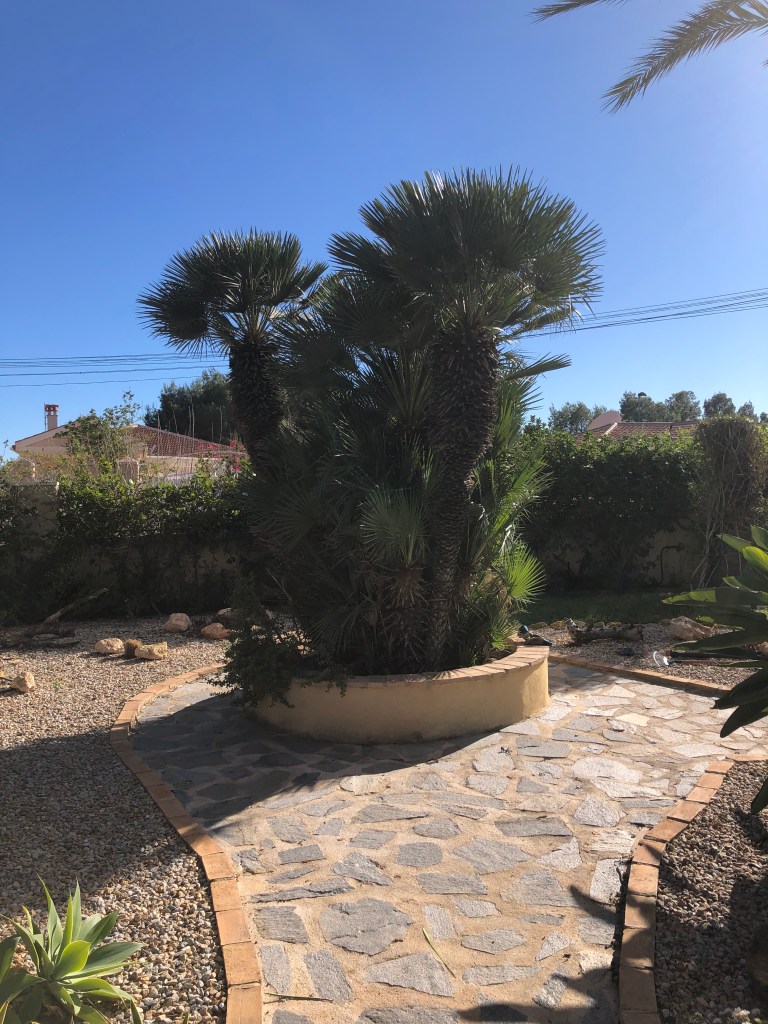
Pruning Sago Palms. Sago palms are one of the most popular plants in Spanish gardens. They can be found planted in the ground or happily growing in pots as their slow growing nature ensures they are happy in pots. To be honest these plants do not need that much pruning especially if you grow them in the way that I do with an exposed trunk. I think that exposing the trunk gets you the best out of the plant; you see the ruggedness of the trunk whilst at the same time appreciating the architectural shape of the fronds. To achieve this look, just get out your lopers and take off all the circles of fronds just leaving the top two circles. This is important as if you ever lose one circle to disease or damage, then you have a reserve. The photo below shows my multi-stem sago palm before and after its trim. Click on each photo for a larger view.


An interesting and rewarding part of sago palms is that they will throw off “pups” at their base. These in effect are mini sago palms that can be removed and cultivated. I am not doing this at the moment as I am too busy, but this is the process if you fancy having a go.
- Clear the earth away from the pup to expose a hard coco nut shaped growth
- You need to separate this growth from the trunk by cutting down with a sharp spade or similar
- Once you have removed the pup cut off all the fronds attached to it
- Place the now frondless pup in a shaded dry area for two weeks to allow the scar where you have cut time to scale over
- After two weeks place the pup in a compost mixture of 60/40 compost to sand and place it into a very tight pot and place in bright but not full sun
- Water once then leave it till the soil is completely dry and then water sparingly
- If you are lucky, in about a month you should see some growth
The photos below show some photos of my ready to harvest pups. I have cut one side of the fronds off so you can get a better look. Click on each photo for a larger view.

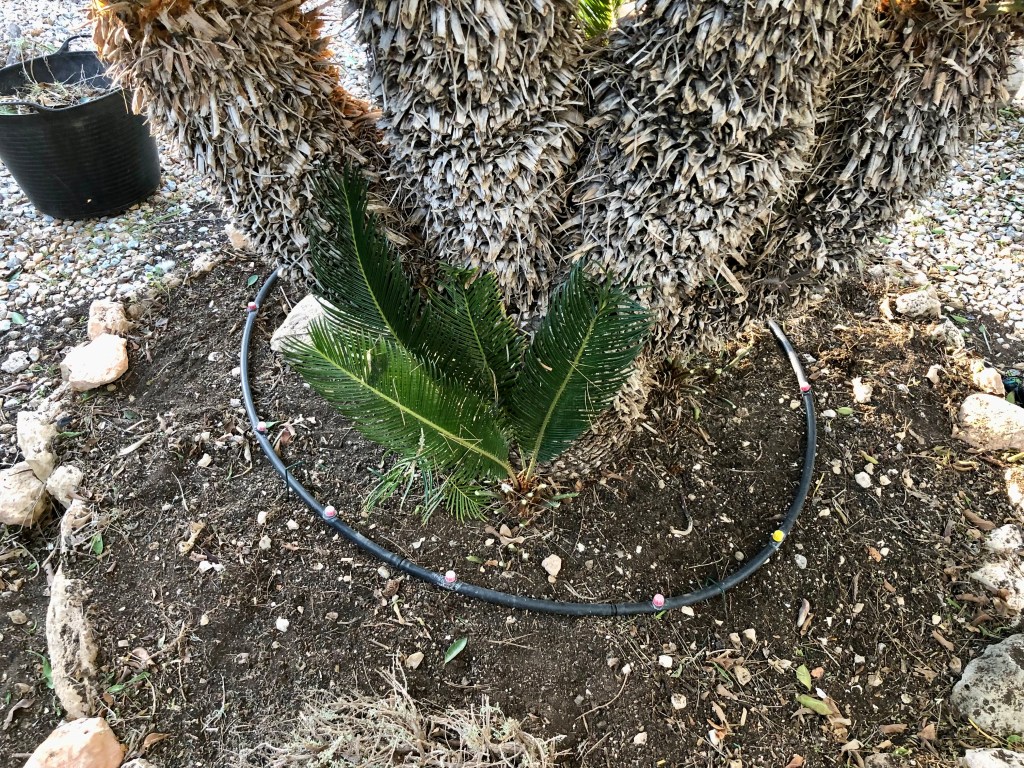
Cutting back hedges. I consider a good mixed hedge to be one of the delights of living in Spain. Far too many people surround their property with high sterile walls that stop any meaningful growth in their shade. Planted correctly hedges can give you all the security of a wall, but at the same time can delight you with different foliage and flowers not to mention abundant wild life.
I have a rather unorthodox approach to hedge planting. I have over two hundred metres of a variety of mixed hedges all of which are planted closer than normally recommended so that they eventually form a thick impenetrable wall of living colour with each hedge flowering like crazy as it fights for its space. This means that all I have to do is get my hedge trimmers out and trim it all back to the desired height each year and leave it to get on with it again.
When I say all I have to do, to be honest it is like a military operation assembling all the ladders, platforms and tools needed to do this job. The first picture below shows me beginning to gear up for the task in hand. Whilst the subsequent three pictures show parts of the actual task in hand. Click on each photo for a larger view.

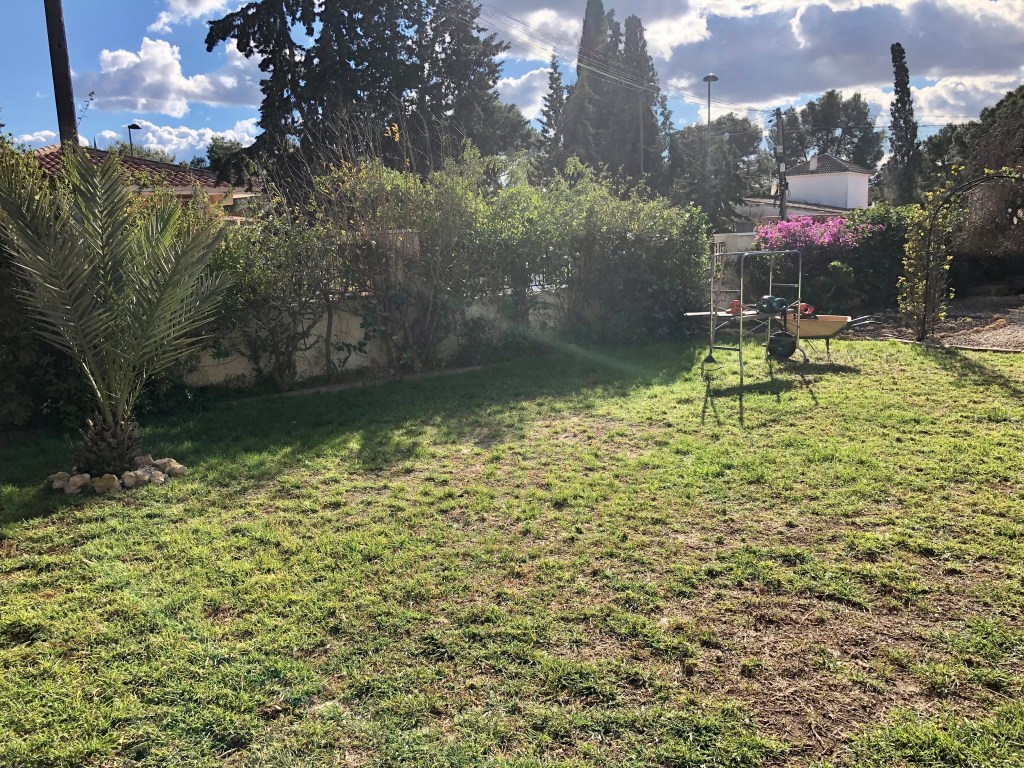


Finally below you can see the finished hedges in all their glory.


Preparing my defence. Unfortunately, as I mentioned earlier I have to spend most of my evenings locked in my room preparing my defence against the summons served on me by the Chief Diversity and Inclusion Officer of the National Chicken Council on account of my alleged slander of calling Cruella (my wife’s) chickens fat. The nub of Cruella’s case rest on the fact that she has sworn an affidavit saying that her chickens are only fed normal chicken food and therefore cannot be deemed fat.
I on the other hand have mounted a defence that no ordinary chickens could be as fat as these unless they were getting extra food. To assist my defence I have been secretly monitoring Cruella and her chicken feeding habits. The first thing I noticed was that some of the chickens gather inside Tango the blind Labradors old kennel every time he is fed (10am and 3pm). The photo below shows the assembly starting. This spot is just beside where Tango’s food is kept and where he is fed.
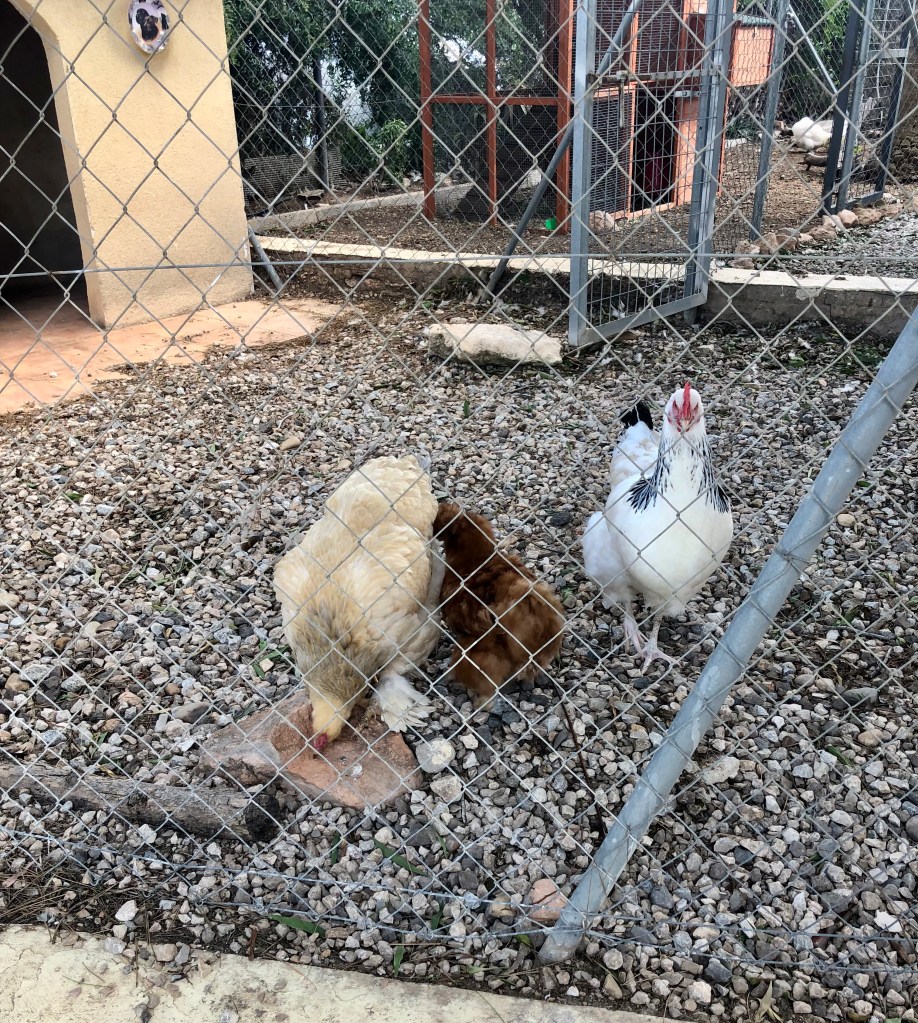
By mounting a hidden camera I now have proof that Cruella is illicitly feeding her chickens with high calorie insect treats that obviously encourage obesity in chickens. The photos below are legal dynamite as they not only show excess feeding taking place, but I have also included a photo of the illicit feed. Click on each photo for a larger view.

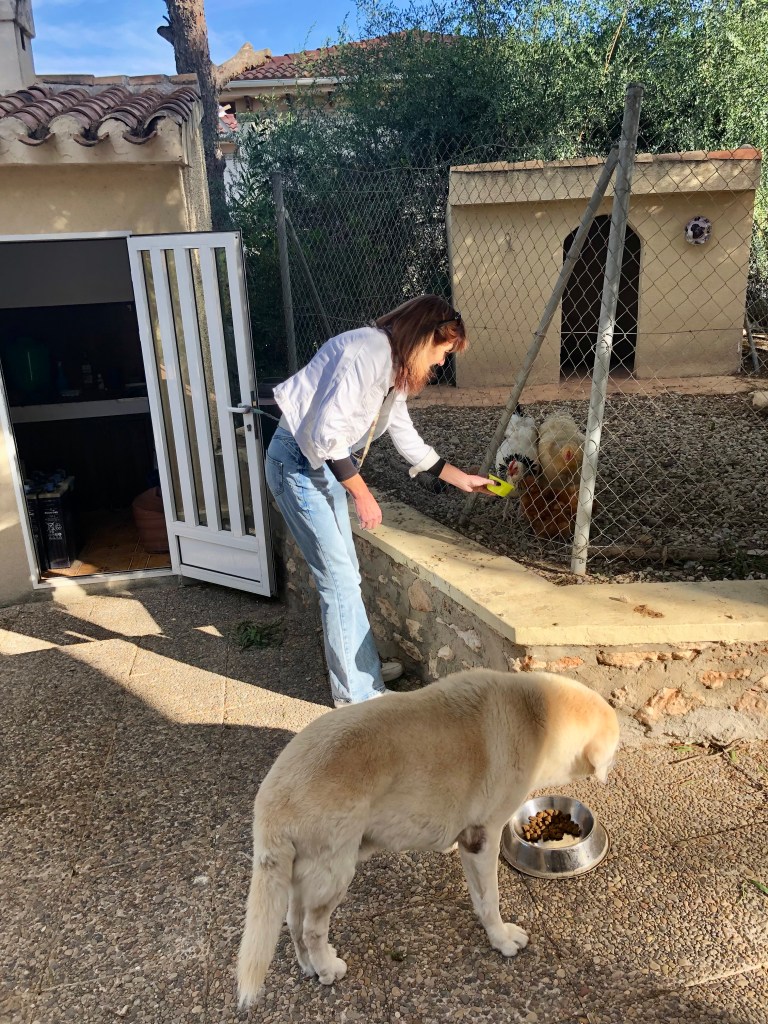
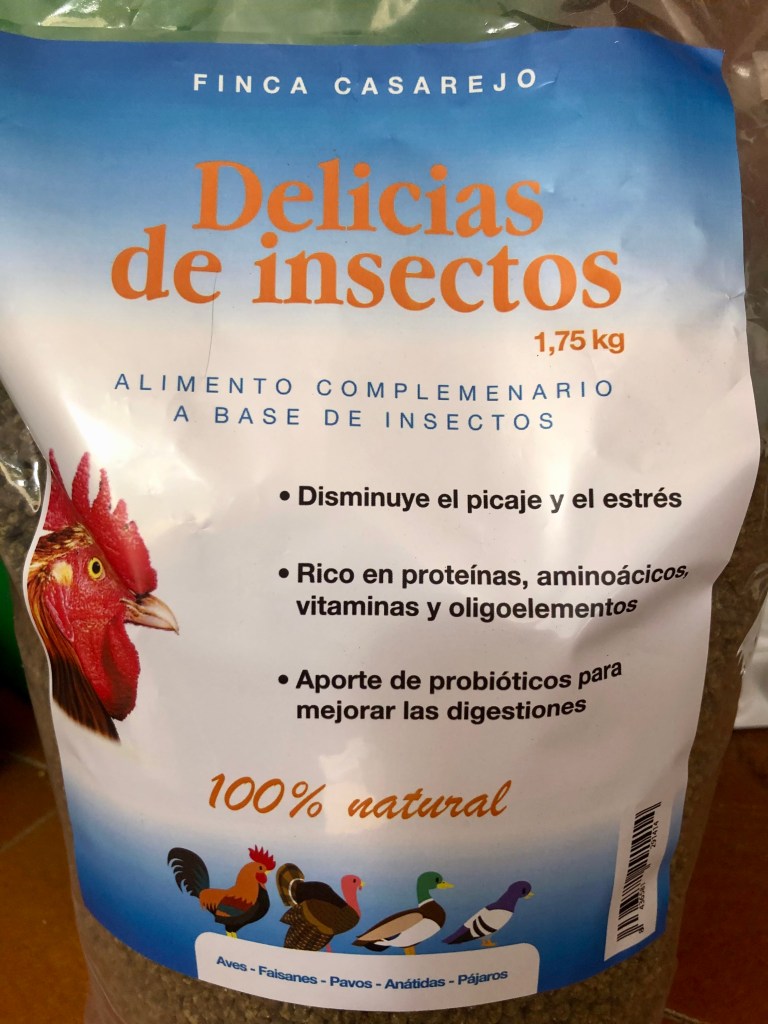
Confronted by my portfolio of evidence Cruella has admitted that she may have acted hastily and has subsequently written to the Chief Diversity and Inclusion Officer of the National Chicken Council withdrawing all allegations against me. Unfortunately, all of this has drained me and I am not currently up to battling with the big Ficus tree so there will be a Part 4 of the big cutback.


European fan palm also produces basal pups. That is likely what the crowded basal growth is, rather than seedlings. I can not remember ever finding a seedling.
LikeLike